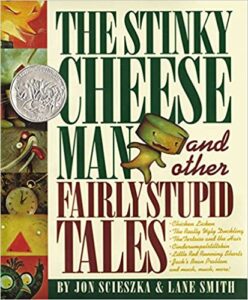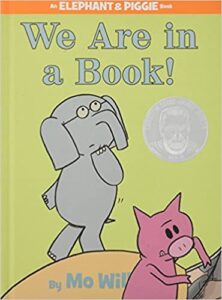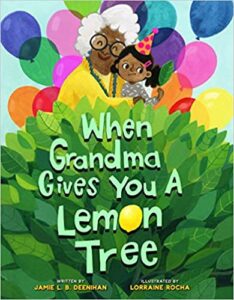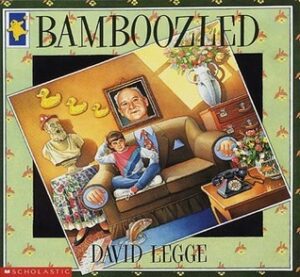Postmodern literature
After World War II, a new movement in literature began: postmodernism. Postmodern literature rose to prominence in the late 1950s and early 1960s. This form of literature is characterized by the use of metafiction, unreliable narration, self-reflexivity, and intertextuality.
Postmodern Picture Books
The classic postmodern picture book is BLACK AND WHITE (1990) by David Macaulay. The book received mixed reviews and the Caldecott Medal for illustration in 1991. The text on the first page reads:

The text on the first page reads:
Each spread has four quadrants. On each quadrant, one story is told. In total, four stories.
The other example of a postmodern picture book is THE THREE PIGS (2001) by David Wiesner. The book received the Caldecott Medal for illustration in 2002. In this book, one of the pigs decides to climb outside of the text and the story reveals the pig’s adventure afterward.

Another example is THE STINKY CHEESE MAN: AND OTHER FAIRLY STUPID TALES (1992) by Jon Scieszka and Lane Smith. The book received Caldecott Honor Book in 1993.

Another postmodern picture book is BAMBOOZLED (1994) by David Legge. The story is about a girl who visits her grandfather and feels something is unusual. What makes this book different is the illustration. On each page, the illustration shows that you wouldn’t see either in children’s books or in reality. For example, the text says that grandfather feeds the cat and the illustration shows a lion, with an apron, sitting in a baby chair and grandfather spoon-feeding it! There are many of these unusual things.
All of the examples I found were published before 2000 and those which won a prize were for their illustration, not for their stories. To me, it seems that publishing postmodern picture books WAS a trend, but not anymore.
Metafiction
In the postmodern litterateur, we frequently see authors use the metafiction writing style. The term metafiction was coined by US author William H Gass in 1970.
Metafiction is a writing style in which the author reminds the reader that this is fiction, not reality, and speaks directly to the reader. The Narrator or the characters are aware that they are part of a fictional world, not a real world
One of the prominent metafiction novels is IF ON A WINTER’S NIGHT A TRAVELER (1979) by Italian author Italo Calvino. The book starts with:
Each chapter of the book has two sections. The first part talks with “you” (the reader) and the second section tell the story.
Metafiction is also referred to as breaking the fourth wall. The phrase comes from theater. The stage has three walls—one back and two sides. The fourth wall is the invisible wall between the stage and the audience. Actors and actresses are supposed to pretend the audience is not there. But, if they address the audience directly, then they have broken the fourth wall.
Metafiction vs. Second-person POV
Merely directly speaking to the reader doesn’t make a metafiction story. A Narrator with a second-person POV also speaks directly to the reader. However, metafiction and the second-person POV are intrinsically different. In the former, the Narrator frequently refers to the fictitious nature of the story. There is an element of awareness in it. Whereas in the latter, the Narrator only tells the story.
Let’s compare two picture book examples. WE ARE IN A BOOK! (2010) by Mo Willems

Metafiction
is a metafiction and WHEN GRANDMA GIVES YOU A LEMON TREE (2019) by Jamie L.B. Deenihan and Lorraine Rocha

Second-Person POV
is written in second-person POV. The two characters of WE ARE IN A BOOK, a pig and an elephant, know they are in a book.
And, when the elephant wants to know when the book ends, the illustration shows us that the pig is turned the pages to see that last page. Then it says that the book ends on page 57!
Compare it with a sentence from WHEN GRANDMA GIVES YOU A LEMON TREE
The Narrator speaks with the reader but she never refers to the fact that this is a story.
Metafiction picture books
Most metafiction picture books are humorous. For example, WARNING: DO NOT OPEN THIS BOOK! (2013) by Adam Lehrhaupt and Matthew Forsythe. The book starts with these lines:

Or, A PERFECTLY MESSED-UP STORY (2014) by Patrick McDonnell

Here is a sample sentence from the book:
THE PANDA PROBLEM (2019) by Deborah Underwood and Hannah Marks is an interesting metafiction picture book. The book consists of dialogues between the narrator and the main character—the panda. The narrator insists that the panda speaks about its problems. The panada says:

and the narrator replies:
While writing this blog post, I was pondering whether is metafiction meant only to entertain! Could it be used to speak about tough topics? Or, its self-reflexive aspect can teach children a Social-Emotional Learning topic?
I found only one example that answers my question: A BOOK FOR ESCARGOT (2020) by Dashka Slater and Sydney Hanson.

In this story, a French snail, named Escargot, is in a library and searches for its favorite book. Among the books, Escargot finds a cooking book that is not about cooking food for Escargot, but to cook Escargot as food! I am not going to spoil the story.
I write regularly blog posts about the craft of writing children’s books. PictureBookPedia is all about picture books and ChapterBookPedia is all about chapter books. My quarterly newsletter sends the list of new blog posts to your inbox.


